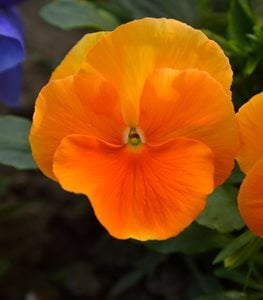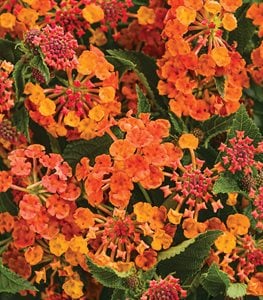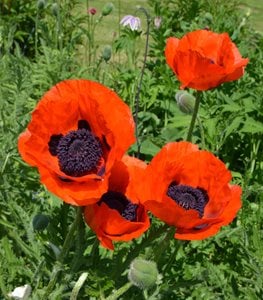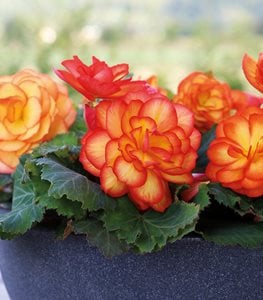25 Best Plants with Orange Flowers
Bring vibrant energy to your garden with these orange-blooming annuals, perennials, bulbs, and vines. Published: 12/7/2022Bold and fiery, orange flowers can’t help but be noticed and command attention wherever you plant them. Although these outgoing bloomers are far from shy, they are more versatile than you might think and deserve a place in the garden in every season. Usher in spring with the dazzling glow of orange-blooming Oriental poppies. Add sizzle to the summer garden with orange zinnias and marigolds. And celebrate the warm colors of fall with container plantings of orange pansies or mums. As long as orange is used judiciously, there is no better color to add spark to a humdrum garden and bring it back to life.
On this page: Annuals | Perennials | Bulbs | Vines | Design Tips
On this page:
ANNUALS WITH ORANGE FLOWERS
CALIBRACHOA
Superbells® Dreamsicle® —
(Calibrachoa hybrids)
Bloom time: Planting to hard frost
Height/Spread: 6 to 12 inches tall, 12 to 24 inches wide
Petite petunia-like flowers look stunning trailing from containers and hanging baskets. For the best display, give plants a light trim on occasion to encourage fuller growth and more abundant flowering. Learn more about growing calibrachoa.
CELOSIA
(Celosia spp.) Exposure: Full sunBloom time: Summer through fall
Height/Spread: 1 to 3 feet tall, 6 to 18 inches wide
These heat-loving flowers come in a variety of eye-catching forms, ranging from feathery plumes to crested cockscombs, in vibrant shades of orange, red, yellow, and pink. One of the newest cultivars is ‘Flamma Orange,‘ an All-America Selections winner lauded for its fade-resistant fiery orange plumes and long season of bloom.
CUPHEA
Vermillionaire® —
(Cuphea hybrids)
Exposure: Full sun
Bloom time: Planting until frost
Height/Spread: 18 to 28 inches tall, 12 to 24 inches wide
Clusters of orange, tubular-shaped flowers with yellow tips look like tiny firecrackers, bringing an explosion of color to containers and garden beds. Irresistible to hummingbirds, cuphea requires no deadheading for continuous bloom. Learn more about growing cuphea.
GERBERA DAISY
(Gerbera jamesonii)
Zones: Usually grown as an annual; perennial in Zones 8-11Exposure: Full sun to partial shade
Bloom time: Late spring through fall
Height/Spread: 8 to 12 inches
The daisy-like flowers of gerberas bloom in nearly every color, from soft pastels to zesty shades of orange and red. Varieties to try include 'Mega Revolution Orange,' which features deep orange petals surrounding cream-colored centers, and ‘Patio Volcanoes,’ which has large orange and yellow bi-color blooms with black eyes. Learn more about growing Gerbera daisies.
IMPATIENS
Infinity® Orange —
(Impatiens hawkeri)
Exposure: Shade to partial sun
Bloom time: Planting to frosts
Height/Spread: 10 to 14 inches tall, 6 to 12 inches wide
Looking for an orange bloomer to bring vibrant, nonstop color to a shady corner? This tough, mildew-resistant impatiens is adaptable to most light conditions and features extra-large flowers that pop against dark-green foliage. Learn more about growing impatiens.
MARIGOLD
(Tagetes spp.)
Exposure: Full sunBloom time: Late spring until frost
Height/Spread: 6 inches to 4 feet tall, 6 inches to 2 feet wide, depending on the variety
This no-fuss annual comes in numerous shades of orange and yellow, often with striking highlights of red, gold, or bronze. In addition to its ornamental value, marigold is a great companion plant in a vegetable garden because it helps repel unwanted pests. Learn more about growing marigold flowers.
PANSY
(Viola x wittrockiana)
Zones: Usually grown as an annual; perennial in Zones 8-11Exposure: Full sun to partial shade
Bloom time: Spring, fall, early winter
Height/Spread: 6 to 9 inches tall, 9 to 12 inches wide
Although pansies are best known for their cheery purple or yellow flowers, you can also find pretty cultivars with orange blooms, such as 'Frizzle Sizzle Orange,' which has ruffled pumpkin-orange flowers, or 'Matrix Orange,' which sports extra-large bright orange blossoms. Where winters are mild, pansies planted in fall will often rebloom again in spring. Learn more about growing pansies.
ZINNIA
(Zinnia spp.)
Exposure: Full sunBloom time: Late spring until frost
Height/Spread: 1 to 4 feet tall, 1 to 2 feet wide
Put some zing into your zinnia patch by including some bright orange bloomers, like ‘Double Zahara Fire’, which sports fully double scarlet-orange blooms, or the more demure ‘Queeny Lime Orange’, a beautiful blend of salmon, orange, peach, and lime. One of the easiest annuals to start from seed, zinnias can be sown directly in the garden after the threat of frost has passed. Learn more about growing zinnias.
PERENNIALS WITH ORANGE FLOWERS
BIRD OF PARADISE
(Strelitzia spp) Zones: 10-12Exposure: Full to partial sun
Bloom time: Late winter to summer, with year-round bloom under optimal growing conditions.
Named for its iridescent orange and blue flowers that resemble a bird in flight, this exotic tropical perennial craves heat and grows best in outdoor temperatures over 60 degrees F. But even if you live in a colder climate, you can enjoy this spectacular plant year-round by potting it up and growing it indoors over winter in a sunny room. Learn more about growing bird of paradise plants.
BLANKET FLOWER
Arizona Apricot —
(Gaillardia spp.)
Exposure: Full sun
Bloom time: Early summer to fall
Height/Spread: 12 inches tall and wide
Large apricot-orange blooms with yellow tips cover tidy mounds of dark green foliage for months on end, bringing long-lasting color to garden beds and borders. This heat- and drought-tolerant prairie native needs little care once established, and the nectar-rich flowers are magnets for butterflies and bees. Learn more about growing blanket flower.
BUTTERFLY WEED
Butterfly weed —
(Asclepias tuberosa)
Exposure: Full sun
Bloom time: Late spring through late summer
Height/Spread: 1 to 2 feet tall, 12 to 18 inches wide
Bearing clusters of bright orange blossoms, this showy cousin of milkweed is a vital food source for monarchs and other butterflies and a beautiful addition to a meadow or pollinator garden. Deadhead faded flowers to encourage more blooms and to prevent the plant from reseeding if you wish to limit its spread.
CHRYSANTHEMUM
(Chrysanthemum grandiflorum)
Zones: 7-9Exposure: Full sun
Bloom time: Late summer through fall
Height/Spread: 14 to 24 inches tall, 20 to 36 inches wide
Available in a wide array of rich, autumnal shades like coppery orange, russet, and burgundy, the garden mum is often used as a fall annual to replace summer-blooming plants in containers and garden beds. Many varieties can also be grown as perennials if you plant them in early spring or at least 6 weeks before a killing frost in fall. Learn more about growing mums.
CONEFLOWER
Color Coded® 'Orange You Awesome' —
(Echinacea hybrids)
Exposure: Full sun to partial shade
Bloom time: Mid to late summer
Height/Spread: 18 to 22 inches tall, 16 to 20 inches wide
A nice change of pace from the familiar purple coneflower, this compact cultivar features large tangerine-orange flowers enhanced by a hint of magenta near the cone. Once the flowers have finished blooming, leave the seed heads in place to attract a multitude of songbirds to your garden. Learn more about growing coneflower.
LANTANA
Luscious® Marmalade —
(Lantana camara)
Exposure: Full sun
Bloom time: From planting until frost
Height/Spread: 20 to 30 inches tall and wide
A beautiful blend of deep orange, yellow, and red, this heat-tolerant bloomer flowers nonstop from late spring until frost and nearly year-round in warmer climates. Usually grown as an annual in cooler climates. A nice, mounded habit makes it a perfect choice for containers, borders, and mass plantings. Learn more about growing lantana.
ORIENTAL POPPY
(Papaver orientale) Zones: 5-7Exposure: Full sun
Bloom time: Spring to early summer
Height/Spread: 2 to 4 feet tall, up to 2 feet wide
Although their time in the spotlight is brief, the crepe papery, vividly colored blooms of Oriental poppies are among the most striking sights in the spring garden, heating it up in blazingly bright hues of orange and red. Because the foliage dies back in midsummer, poppies are best planted in the garden among summer-blooming perennials and annuals that can fill in the gaps during the dormant months. Learn more about growing Oriental poppies.
SNEEZEWEED
(Helenium hybrids)
Zones: 4-9Exposure: Full sun
Bloom time: Midsummer through fall
Height/Spread: 2 to 3 feet tall, 1 to 2 feet wide
The cheerful daisy-like flowers of ‘Mardi Gras’ light up the midsummer garden in a radiant display of burnt orange, yellow, and red, accented by deep brown center cones. Tough and reliable, this prolific bloomer is a great choice for meadow gardens, mixed borders, and cutting gardens. It grows best in moist soils, but will tolerate short periods of drought.
BULBS WITH ORANGE FLOWERS
ASIATIC LILY
(Lilium hybrids)
Zones: 4-9Exposure: Full sun to partial shade
Bloom time: Early to mid-summer
Height: 2 to 3 feet tall
Asiatic lilies are best known for their exceptionally broad range of colors, as well as their wild patterns, brush marks, and speckles. Orange Art ® is an eye-popping blend of pumpkin-orange petals with densely speckled, dark maroon centers. Each stem bears at least half a dozen 5- to 7-inch flowers. Learn more about growing lily flowers.
CANNA
(Canna spp. and hybrids)
Zones: 8-10Exposure: Partial shade to full sun
Bloom time: Early to mid-summer to frost
Height/Spread: 18 inches to over 6 feet, depending on the variety
Massive blooms, in colors ranging from pale pastels to vibrant oranges and reds, turn any garden into a tropical paradise. The huge, jungle-like leaves are equally eye-catching and come in a broad array of solid and variegated colors. Because cannas are sensitive to freezing temperatures, dig up the rhizomes in fall and store until planting time the following spring. Learn more about growing colorful cannas.
CROWN IMPERIAL FRITILLARIA
(Fritillaria imperialis)
Zones: 4-9Exposure: Full sun to partial shade
Bloom time: Spring
Height: 3 to 4 feet tall
This underutilized bulb adds a unique touch to the spring garden, with nodding bell-shaped flowers topped by a flamboyant crown of spiky foliage. The deep orange-red blooms of ‘Rubra Maxima’ are especially dazzling and are accented by prominent, cream-colored stamens. Learn more about growing fritillaria.
CROCOSMIA
(Crocosmia)
Zones: 5-9Exposure: Full sun to partial shade
Bloom time: Mid to late summer
Height: 1-1/2 to 4 feet tall
The lily-like flowers of Crocosmia light up the summer garden in luminous shades of orange, red, and yellow. Unlike other summer-blooming bulbs, this vigorous perennial is hardy down to zone 5 and can stay in the ground year-round in all but the harshest climates. Learn more about growing crocosmia.
TUBEROUS BEGONIA
Nonstop® Fire —
(Begonia x tuberhybrida)
Bloom time: Late spring until frost
Height/Spread: 8 to 12 inches tall, 12 to 24 inches wide
Fully double, rose-like flowers on this nicely mounded plant bring welcome color to shadier areas of the garden. Blooms continuously throughout the summer and fall, producing loads of large, fiery orange flowers. Learn more about growing tuberous begonias.
ORANGE FLOWERING VINES
BLACK-EYED SUSAN VINE
(Thunbergia alata)
Zones: 10-11, usually grown as an annualExposure: Full sun to partial shade
Bloom time: Early summer until frost
Height: Climbs or trails 6 to 8 feet
Available in an array of bright, citrusy hues such as orange, lemon yellow, and tangerine, this fast-growing annual vine produces masses of long-lasting blooms all summer long—all accented by dark centers. Looks stunning when allowed to climb up a trellis, weave through a lattice fence, or cascade over the sides of a hanging basket. Learn more about growing black-eyed Susan vine.
NASTURTIUM
(Tropaeolum majus) Zones: Usually grown as an annualExposure: Full sun
Bloom time: Late spring through fall
Height/Spread: Climbs 1 to 10 feet tall, 1 to 3 feet wide
A staple of kitchen and cottage-style gardens, nasturtium is often used as a companion plant to keep pests away from garden vegetables such as beans, broccoli, cabbage, and squash. The brightly colored blooms are also edible and make a lovely garnish for salads and other dishes.
TRUMPET HONEYSUCKLE
(Lonicera sempervirens)
Zones: 4-9Exposure: Full sun
Bloom time: Late spring to mid-summer
Height: Climbs up to 15 feet
Also known as coral honeysuckle, this non-invasive twining climber produces showy clusters of scarlet and orange tubular flowers that open to reveal yellow throats, drawing a constant parade of hummingbirds and butterflies. Native to the Southeast, it remains evergreen in warmer climates. Learn more about growing honeysuckle vines.
TRUMPET VINE
(Campsis radicans)
Zones: 4-9Exposure: Full sun to partial shade
Bloom time: Mid-summer
Height/spread: 20 to 40 feet tall, 5 to 10 feet wide
Covered by clusters of large funnel-shaped flowers in brilliant shades of orange and scarlet, this vigorous grower is a great screening plant for covering a sturdy arbor or pergola, but may need frequent pruning to keep it under control. Because trumpet vine blooms on new growth, cutting it back in early spring will not affect flowering.
DESIGN TIPS FOR ORANGE FLOWERS
Surprisingly, orange flowers work well with many other colors in the garden, in both classic and unconventional combinations. Here are some ideas for using them to best effect.
- For drama, intermingle orange with shades on the opposite side of the color wheel color, such as blue or purple flowers, like salvia, iris, and cornflower (Centaurea cyanus).
- For a touch of the tropics, combine orange with hot pink, red, and yellow flowers.
- Achieve a sophisticated look by pairing orange with white or cream-colored flowers or plants with bronze foliage.
- Orange is one of the best colors to pair with almost-black flowers or foliage, creating intense contrast. In fall, you can often find Halloween pansy mixes that combine these two colors.
- Keep in mind that not all shades of orange are bold and bright. Softer hues like apricot, salmon, coral, or melon are often easier to incorporate into the garden while still imparting a nice glow.




























